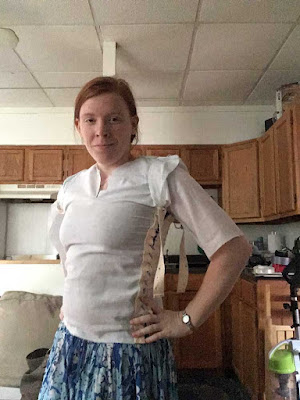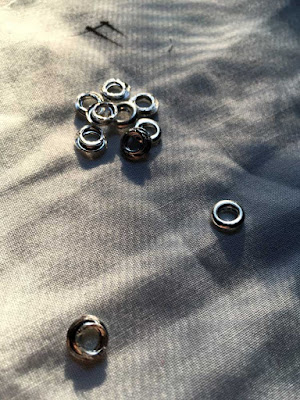Why You Shouldn't Use Cheap Grommets
This is a cautionary tale about cheap grommets, as well as proof that I really did fit the bodice and test the sleeves before cutting into my silk. Wild.
A few months ago, I made some quick-lacing tapes after reading about a costumer who used them to test-fit corsets without having to bind six hundred eyelets only to discover the thing didn't fit at all. Brilliant, I thought, that would make fitting laced garments so much easier. Only I'm always cheap and often lazy, so I just got the 100-for-a-buck grommets at Joann's and some heavy cotton tapes and had at them with the leather punch and a hammer. They weren't perfect, and I did have to reset a few when they didn't quite crimp over the thick material, but after all these were just to test mockups.
They didn't need to be perfect, right?
Ehhhh...well...perfect might be overkill, but sturdy and well-made wouldn't be. More on that later. Let's fit the bodice first. (Technically that started by stitching the shoulders, basting quick-lace tapes onto the side openings, and attaching rectangular sleeves, but none of those processes are terribly fascinating to photograph, so I didn't.)
So, initial fitting: I have Medieval Boobs™ for sure, and the vertical wrinkles at the neckline and shoulders are not too far off what sculptures and illuminations often show, but the skin-tight stomach leaves something to be desired. This is also a great demonstration of Why Sabine Doesn't Wear Butterfly Sleeves.
A bit of scuffling with the lower half of the bodice and the lacing gives better horizontal wrinkles. Huzzah, this bodice shape is (in general) going to work. Time to fiddle with the sleeves.
In my prior bliaut, I used rectangular or very nearly rectangular pieces for the upper sleeves, sewn as straight as possible on the bodice and with about four inches left open at the underarm before the sleeve seam begins. These aren't uncomfortable, but they do pull awkwardly at times, and after a few years of wear the back corners of the sleeve-to-bodice seam are showing significant strain. Clearly there is improvement to be made, as even royal women did some physical work in the 12th century (and I, the 21st-century woman, would like the option).
This is the part where you imagine approximately twelve photos of pinned-sewn-ripped-pinned-sewn-again-reripped-and-furiously-sewn-without-the-benefit-of-pinning sleeves. There were words. Also gestures, and scowls.
And here we have one fitted sleeve, and a pose that demonstrates a certain amount of mobility! I'm not showing you the other sleeve because I didn't fit it. Bad seamstress...but this is after all only the first mockup. You can also see that the sides are laced to touching, if not to overlapping, which isn't quite the effect I want. There are at least two illuminations, as well as the Angers cathedral sculpture, that clearly show a gap of a few inches at ladies' sides where the chemise (or maybe an underdress) shows under the laces. I'd also like to eliminate that big horizontal wrinkle at the top of the lacing. It may be partially a relic of clumsy pinning, but more likely it's excess fabric in the bodice I might be able to remove with a bit of alteration.
Meanwhile, the adorable and extremely early-Victorian little cap sleeve is the result of gradually pinching out and pinning and sewing excess fabric until I could move my shoulder freely and close the sleeve seam without straining to match the ends.With the sleeve trim on the straight grain, I'd really like to keep the sleeve itself also on-grain so I don't have to deal with unmatched stretching and shifting from wear and the weight of the lower sleeves later.
The front and back curves of the sleeve head are anything but matching; a deeper slope on the front edge makes the sleeve angle forward a bit—useful for a greater range of motion, since human shoulders really don't allow that much movement behind the body, but we routinely move our arms across the front of the torso. The bottom edges don't need to match because, as on my earlier bliaut, I'm going to leave the first four inches or so unsewn.
It's hard to tell in the photo, but the bodice does not have a correspondingly deeper armscye on the front. No, I don't know why. Presumably I could balance the adjustment on the sleeve with that on the bodice, but while I am a reasonably skilled seamstress, the world of patterning remains somewhat mysterious. It fits well, and is a good starting point for the next mockup, and I'm satisfied with that.
Back to the grommets. The cheap, 100-for-a-buck grommets. Under the strain of me wriggling into and out of the bodice several times, and loosening and tightening laces to do so, about a quarter of the grommets flung up their tiny metallic hands and shrieked that they simply could not work under these conditions. So they didn't. Sigh. The remaining ones may find jobs as a decorative edging on a thin skirt, where they won't be asked to really do anything.
If you need me (after this dress is finished), I'll be binding eyelets so I can have quick-lacing tapes that don't need significant repair every time I use them—because other than the grommet failure, they worked marvelously.
Next mockup: smooth out sleeve head and armscye curves from this attempt, narrow body panels by about an inch either side, phone a friend to check the fit without contorting like a member of Cirque du Soleil, pin or trace collar onto bodice pieces to check scale.
A few months ago, I made some quick-lacing tapes after reading about a costumer who used them to test-fit corsets without having to bind six hundred eyelets only to discover the thing didn't fit at all. Brilliant, I thought, that would make fitting laced garments so much easier. Only I'm always cheap and often lazy, so I just got the 100-for-a-buck grommets at Joann's and some heavy cotton tapes and had at them with the leather punch and a hammer. They weren't perfect, and I did have to reset a few when they didn't quite crimp over the thick material, but after all these were just to test mockups.
They didn't need to be perfect, right?
Ehhhh...well...perfect might be overkill, but sturdy and well-made wouldn't be. More on that later. Let's fit the bodice first. (Technically that started by stitching the shoulders, basting quick-lace tapes onto the side openings, and attaching rectangular sleeves, but none of those processes are terribly fascinating to photograph, so I didn't.)
 |
| I have a lot of stuff on my counters...but you can't see the sink full of dishes! |
 |
| Pretty close to the illuminations now. |
In my prior bliaut, I used rectangular or very nearly rectangular pieces for the upper sleeves, sewn as straight as possible on the bodice and with about four inches left open at the underarm before the sleeve seam begins. These aren't uncomfortable, but they do pull awkwardly at times, and after a few years of wear the back corners of the sleeve-to-bodice seam are showing significant strain. Clearly there is improvement to be made, as even royal women did some physical work in the 12th century (and I, the 21st-century woman, would like the option).
This is the part where you imagine approximately twelve photos of pinned-sewn-ripped-pinned-sewn-again-reripped-and-furiously-sewn-without-the-benefit-of-pinning sleeves. There were words. Also gestures, and scowls.
 |
| Never mind the hanging tapes and funny little cap sleeve. |
Meanwhile, the adorable and extremely early-Victorian little cap sleeve is the result of gradually pinching out and pinning and sewing excess fabric until I could move my shoulder freely and close the sleeve seam without straining to match the ends.With the sleeve trim on the straight grain, I'd really like to keep the sleeve itself also on-grain so I don't have to deal with unmatched stretching and shifting from wear and the weight of the lower sleeves later.
 |
| After careful marking and trimming, I have quite the shaped sleeve head and armscye. |
It's hard to tell in the photo, but the bodice does not have a correspondingly deeper armscye on the front. No, I don't know why. Presumably I could balance the adjustment on the sleeve with that on the bodice, but while I am a reasonably skilled seamstress, the world of patterning remains somewhat mysterious. It fits well, and is a good starting point for the next mockup, and I'm satisfied with that.
 |
| F A I L U R E S. |
If you need me (after this dress is finished), I'll be binding eyelets so I can have quick-lacing tapes that don't need significant repair every time I use them—because other than the grommet failure, they worked marvelously.
Next mockup: smooth out sleeve head and armscye curves from this attempt, narrow body panels by about an inch either side, phone a friend to check the fit without contorting like a member of Cirque du Soleil, pin or trace collar onto bodice pieces to check scale.
Comments
Post a Comment